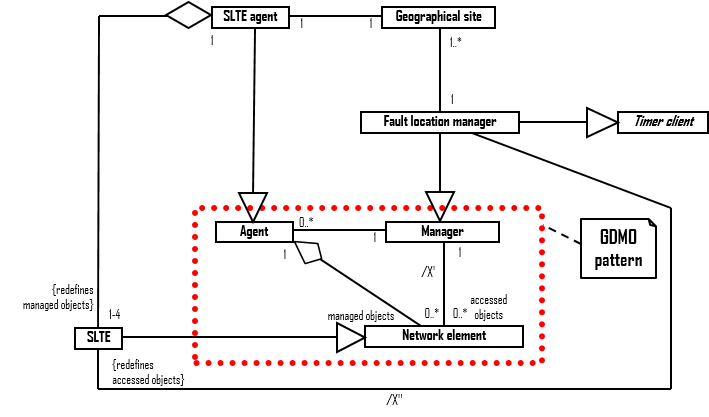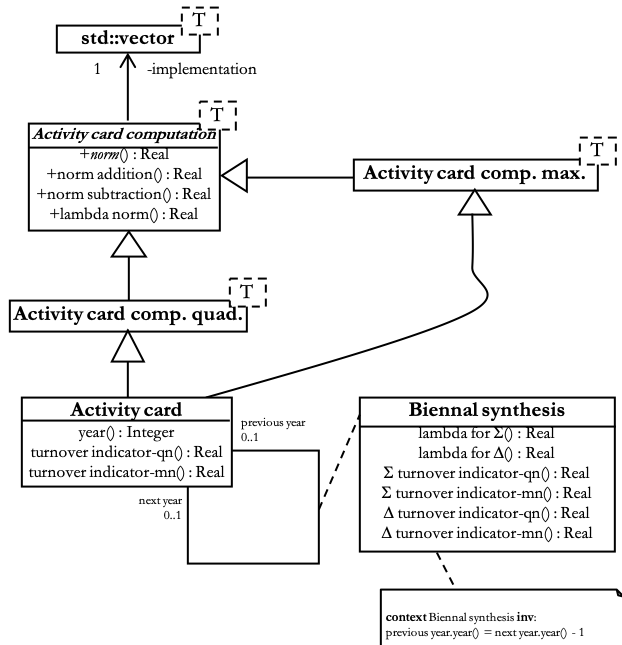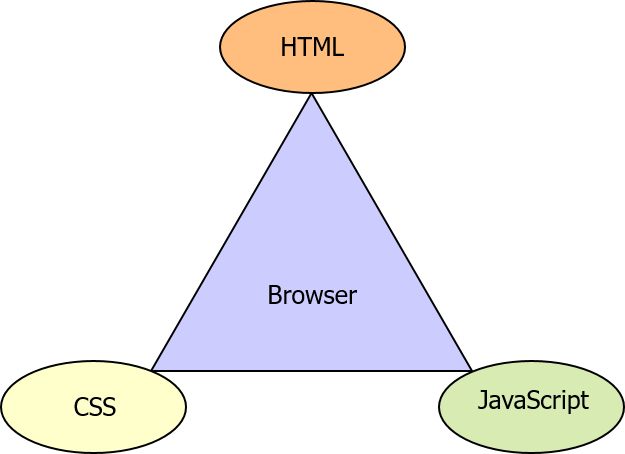

This -Design patterns- tutorial is licensed under a Creative Commons Attribution-NonCommercial 4.0 International License


This tutorial is a concise overview of Design patterns. The purpose of this tutorial is to show that the two key notions behind OO programming are: design with reuse and design for reuse. To that extent, Design patterns is an informal software design method that singles out code architectural styles (a.k.a. patterns). Design patterns may preexist in software libraries and, therefore, they are reused “as is” (design with reuse) with the least possible adaptations. On the other hand, new code has to be organized by following schemes promoted by Design patterns (design for reuse).
Economical quality features (direct impact)
- Reusability
- Maintainability
- Reliability (correctness)
Social quality features (direct impact)
- Reliability (integrity, safety-critical applications versus error-free applications that maintain corporate identity)
- Scalability (including performance)
- Security
- Ease of use
Other key quality features
- Portability (including interoperability)
- Sustainability
- Etc.
Design with reuse encompasses the search, the selection and the controlled integration of trusted software pieces with cost-effectiveness and time-effectiveness (productivity...). The reuse process is a suite of three key phases, namely analysis, design and programming as it follows.
Analysis
As shown above, white rectangles are “business objects” coming from business analysis.
Design
At design time, business objects are assigned to library components (gray rectangles) in order to elaborate on how business services may rely on technical functions in these components.
Programming
At programming time, glue code allows the effective connection. Often, library components cannot be reused “as is”. Dots in gray rectangles mimic such an adaptation so that library components become fully integrable.
Software architecture with UML

Design for reuse (see Template design pattern) Composite design pattern Software composites delegate or forward business operations to child components. Children may themselves be composites or not (leafs).

Archetype
UML aggregation (white diamond) and composition (black diamond) relationships (C++
)

template<typename T> class Role : public set<T*, less<T*> > { template<typename T> class Composite : public Role<T> { … template<typename T> class Component : public Role<T> { … template<typename Whole, typename Part> class Aggregation; template<typename Whole, typename Part> class _Aggregation { friend class Aggregation<Whole, Part>; … template<typename Whole, typename Part> class Aggregation { private: static map<string, _Aggregation<Whole, Part>, less<string> > _aggregation; string _name; … class Network_element { }; class Manager; class Agent { public: virtual Role<Manager> manager() const = 0; virtual Composite<Network_element> managed_objects() const = 0; }; class Manager { public: virtual Role<Agent> agent() const = 0; virtual Role<Network_element> accessed_objects() const = 0; };
The Data Access Object design pattern delivers raw data while hiding the technical mechanism of accessing data, more often, in databases. For example, greenDAO is devoted to the Android system to manage embedded databases. In Java 8, Java Persistence API -JPA- is a standardized persistence framework within the Java Virtual Machine (JVM); JPA itself encapsulates Java DataBase Connectivty (JDBC): the underlying mechanism based on varied database drivers to effectively get the data.
Archetype (Java)
Entity Beans in the Enterprise JavaBeans™ (EJB) technology or Plain Old Data Objects (POJOs) in Hibernate
Here…
Archetype (C++)
namespace New_York_City_Penitentiary { inline namespace DAOs { class Criminal_case { ... }; … } namespace Nominal { class Prisoner { const std::string _prison_file_number; std::string _given_name; std::string _surname; std::tm _date_of_birth; std::string _place_of_birth; std::tm _date_of_incarceration; const Criminal_case * _incarceration_main; public: explicit Prisoner(const std::string&); bool operator<(const Prisoner&) const; // For 'std::set' std::string get_prison_file_number() const; std::string get_given_name() const; void set_given_name(const std::string&); const std::string& get_surname() const; void set_surname(const std::string&); std::tm get_date_of_birth() const; void set_date_of_birth(const std::tm&); std::string get_place_of_birth() const; void set_place_of_birth(const std::string&); std::tm get_date_of_incarceration() const; void set_date_of_incarceration(const std::tm&); const Criminal_case* get_incarceration_main() const; void set_incarceration_main(const Criminal_case *); std::string toString(); }; class Prisoner_hash { // For 'std::unordered_set' public: std::size_t operator()(Prisoner const&); }; } … }
The Data Transfer Object design pattern is dedicated to the delivery of primitive data from DAOs with lightweight transformations (filering, aggregating, sorting…). No complex processing (billing, statistics, analytics…) occurs DTOs naturally play the role of façade objects for DAOs.
Archetype (Java)
Stateless Session Beans in the Enterprise JavaBeans™ (EJB) technology
Here…
Façade design pattern Archetype (Java)
Session Beans in the Enterprise JavaBeans™ (EJB) technology
Here…
Factory design pattern A factory object (e.g., car factory) generates instances a given type, say “Car” from (utility) class methods in general instead of using a
newoperator in particular.
Archetype (C++)
// '.h' file: template<typename O, typename P> class Factory { public: static O GetInstance(const P& p) { O o(p); return o; } // Deletion of 'o'... static O GetClone(O& o) { // Overloads raise combinatory problems in case of multiple anonymous types... // Change 'o' in some way... O _o = o; // 'O _o(o);' return _o; } // Deletion of '_o'... static O GetClone(const O& o) { // Overloads raise combinatory problems in case of multiple anonymous types... // Change 'o' in some way... O _o = o; // 'O _o(o);' return _o; } // Deletion of '_o'... static O GetClone(O&& o) { // Change 'o' in some way... O _o(std::forward<O>(o)); // Forwards lvalue as either lvalue or as rvalue, depending on 'O'... return _o; } // Deletion of '_o'... }; class Person : public Factory<Person, std::string> { … }; // '.cpp' file: Person someone; someone = Person::GetInstance("someone"); // Move assignmentArchetype (Java) here…
Archetype (Java)
- Observer historically embodies the principles of state change and notification behind the Model-View-Controller (MVC) programming paradigm. One of the Java native supports of Observer is deprecated. Indeed, both the
java.util.Observableclass and thejava.util.Observerinterface aim at being forgotten…- Instead, the Java native supports of Observer in
java.beans(JavaBeans™ technology) still persist through these two classes:«class»java.util.EventObject⇧ «class»Two interfaces also play a great role in the Java native supports of Observer injava.util.PropertyChangeEventjava.beans:«interface»java.util.EventListener⇧ «interface»java.beans.PropertyChangeListenerJavaBeans™ Component Model (tutorial)
- Java Specification Request (JSR): JavaBeans™ is fully part of Java SE
- A Java bean is nothing else than a Java class with a special pattern
- Properties are associated with getter and setter methods with special naming rules:
given_nameleads togetGiven_name(getter) andsetGiven_name(setter)- Binary storage:
java.io.Serializable- Event-based programming
- Integrated documentation for easier exchange (reuse) and standardized processing/manipulation in (no longer supported!) dedicated tools like the Beans Development Kit (BDK)
- Inspired by the MVC paradigm
- Invented for composability (“Components are for composition”, Szyperski et al.)
Run indicator(as part of a programmable thermostat) in JavaBeans™public interface Run_indicator_client extends java.beans.PropertyChangeListener {…} public class Programmable_thermostat extends … implements Run_indicator_client, … {…} public class Run_indicator implements java.io.Serializable { … public Run_indicator(Run_indicator_client programmable_thermostat) throws Statechart_exception { … propertySupport = new java.beans.PropertyChangeSupport(this); propertySupport.addPropertyChangeListener(programmable_thermostat); } public void off() throws Statechart_exception { _Run_indicator.fires(_Something_on,_Everything_off); _Run_indicator.run_to_completion(); _setStatus(_Run_indicator.current_state()); } private void _setStatus(String newValue) { String oldValue = status; status = newValue; propertySupport.firePropertyChange("Run indicator status",oldValue,newValue); } … }
Intent
Service consumption may stumble over issues like unavailability, quality of returned data (nature, complexity…), changes in pricing policy, etc. Service activator is a uniform entry point hiding the routing to various effective competing services. Choice of consumed service may then operate from concerns about failure, performance, security…
Archetype (Java)
public class Currency_conversion_service_activator { public static void main(String[] args) { try { // Single currency conversion, for instance, from US $1000 to €: System.out.println("OpenExchangeRates.org: " + Double.toString(OpenExchangeRates.Convert(Currencies.USD, Currencies.EUR, 1000.)) + '\u20A0'); System.out.println("OpenExchangeRates.org: " + Double.toString(OpenExchangeRates.Convert2(Currencies.USD, Currencies.EUR, 1000.)) + '\u20A0'); // Paying clients only, i.e., a Java exception is raised because HTTPS access requires payment: System.out.println(Double.toString(OpenExchangeRates.Convert3(Currencies.USD, Currencies.EUR, 1000.)) + '\u20A0'); } catch (java.net.MalformedURLException mfue) { // 'MalformedURLException' inherits from 'IOException' System.err.println(java.net.MalformedURLException.class.getSimpleName() + ": " + mfue.getMessage()); } catch (java.io.IOException ioe) { System.err.println("Call 'OpenExchangeRates.org' through HTTPS is subject to payment, so it fails: " + ioe.getMessage()); try { System.out.println("Fixer.io: " + Double.toString(Fixer.Convert(Currencies.USD, Currencies.EUR, 1000.)) + '\u20A0'); } catch (java.io.IOException ioe_) { System.err.println("Call 'Fixer.io' fails as well: " + ioe_.getMessage()); } } } }Archetype (Java 9)
Here…
Archetype (C++)
class Global_exception_management { // No instance required! public: static void my_unexpected(); static void my_terminate(); };Archetype (Java)
Singleton Session Beans in the Enterprise JavaBeans™ (EJB) technology here…
Exercise (Java)
- Create and record single instance through static initialiser here…
- Serve single instance through
Getstatic method- Override default constructor visibility: package ⤳
private
Archetype (Java)
java.util.Comparator<T>interface here…Exercise
- Il y a les plats chauds et les plats froids
- Une salade niçoise végétarienne est sans thon et sans anchois alors qu'une salade niçoise végétalienne est végétarienne et sans oeufs. Les 3 variations sont des plats froids…
- Créer la classe
Platavec la méthoderealiserainsi que les plats chauds (realiser = préparer puis cuire) et froids (réaliser = préparer) par héritage- Créer les classes
Legume,Legume_feuilleetMesclunpar héritage avec la méthodepreparer- Préparer une salade niçoise consiste en partie à préparer les légumes (mesclun…) qui la composent
Intent
Enhancement flexibility and uniformity in a chain of processing (checking typically) steps.
Archetype (Java)

public interface Disability { default public String attestation() { return "Bla Bla Bla..."; } public enum Equipment { Crutch, None, Wheelchair // Etc. } default Equipment equipment() { return Equipment.None; } default int escort() { return 0; // Number of support people } } … @java.lang.FunctionalInterface public interface Responsibility_link { // Variable number of responsibility links in chain: boolean run(final Disability disability, Responsibility_link... followers); } … class Paraplegia implements Disability { @Override public String attestation() { return "Paraplegia"; } @Override public Equipment equipment() { return Equipment.Wheelchair; } } public class Chain_of_responsibility { public static void main(String[] args) { Responsibility_link attestation = (disability, chain_of_responsibility) -> { return disability.attestation().equals("Bla Bla Bla...") ? false : chain_of_responsibility.length == 0 ? true // Performance issue (initial primitive array is copied without first element): : chain_of_responsibility[0].run(disability, java.util.Arrays.copyOfRange(chain_of_responsibility, 1, chain_of_responsibility.length)); }; Responsibility_link equipment = (disability, chain_of_responsibility) -> { return disability.equipment() == Disability.Equipment.None ? false : chain_of_responsibility.length == 0 ? true : chain_of_responsibility[0].run(disability, java.util.Arrays.copyOfRange(chain_of_responsibility, 1, chain_of_responsibility.length)); }; Responsibility_link escort = (disability, chain_of_responsibility) -> { return disability.escort() > 1 ? false : chain_of_responsibility.length == 0 ? true : chain_of_responsibility[0].run(disability, java.util.Arrays.copyOfRange(chain_of_responsibility, 1, chain_of_responsibility.length)); }; System.out.println("Event access? " + attestation.run(new Paraplegia(), equipment, escort)); } }Exercise
Etendre le code pour établir si la nature du handicap est mentale, physique (par défaut) ou les deux. Créer un nouveau maillon dans la chaine en deuxième position qui contrôle cette nature sachant que l'accès à un événement pose problème pour une personne cumulant « mentale » et « physique ». Créer le handicap « Alzheimer » pour lequel une seule escorte est nécessaire et tester son accessibilité à un événement.
Intent
Components autonomously manage their internal (complex) state so that they react to requests (a.k.a. “events”, “messages”) in different ways depending upon their current state. The complex nature of their internal state relies on substates, which may be concomittant, nested…
Archetype (Java) here…
Intent
Memory sobriety prompts us to divide the state of an object between its intrinsic state (immutable, setup at construction time) and its extrinsic state (mutable through operations in particular).
Archetype (UML)
Exercise
Implanter le modèle UML en Java en palliant les failles, en l'occurrence il doit exister un pool d'objets
Cardans lequel rechercher à la construction d'un objetFunctional car. Si non trouvé alors construire un objetCaret l'ajouter au pool. Par confort, ajouter un constructeur à 5 arguments pourFunctional car. Toutefois, quel problème engendre ce constructeur ?
Archetype
Graphical User Interface (GUI) libraries provide template classes (shapes, windows…) with common drawing and interaction capabilities. Customization (through inheritance in general) then relies on template completion.
Case study (requirements)
Requirements, first part
Requirements, second part
Case study (analysis)
Analysis model sample
Case study (design for reuse)
Bad design (1/2)
Bad design (2/2)
In fact, the two bad designs above do not favor maintainability at the time a third norm calculation would be introduced in the application. To better manage this potential evolution, the two good designs below are based on the Template design pattern. Namely the
Activity card computation(generic) class is abstract with two concrete (generic) subclasses,Activity card comp. quad.andActivity card comp. max.that both implement thenormabstract function inActivity card computation.Good design (inheritance)
Good design (composition)
Case study (design with reuse)
Programming model sample (reuse through composition)

Programming model sample (reuse through multiple inheritance)
Implementation in C++

template<typename T> class Activity_card_computation { ... protected: std::vector<T> _implementation; public: ... // Constructors and destructors here… virtual double norm() const = 0; double norm_addition(const Activity_card_computation& v) const { return (*this +v).norm(); } double norm_subtraction(const Activity_card_computation& v) const { return (*this -v).norm(); } double lambda_norm(const double lambda) const { return std::fabs(lambda) * norm(); } ... };Implementation in Java

abstract public class Activity_card_computation<T extends Number> extends Number { ... protected java.util.Activity_card_computation<Number> _implementation; ... // Constructors here… abstract public double norm(); public double norm_addition(final Activity_card_computation<T> v) { return this.plus(v).norm(); } public double norm_subtraction(final Activity_card_computation<T> v) { return this.minus(v).norm(); } public double lambda_norm(final double lambda) { return Math.abs(lambda) * norm(); } ... }Exercise
A partir de l'implantation Java du modèle UML here…, ajouter les classes Plan Epargne Logement -PEL- et Livret de Développement Durable et Solidaire -LDDS-.
MVC comes from the Smalltalk programming language, which nativly offers the
Model,View, andControllerabstract (i.e., template) classes. Followers were the majority, e.g.,CDocument/CViewin Visual C++ ver. 1.0 or Swing GUI library in Java.Event-based programming, service computing and many other paradigmes are born from MVC.
Archetype (MVC within the Web)

Principle
Model: une instance de classe dans laquelle des données métier sont stockées, des états sont maintenus, des constantes sont définies… sans préjuger de la façon dont tout ou partie de ces éléments sont affichés.View: une ou plusieurs instances de classes graphiques (widgets) qui incarne(nt) une représentation sur écran « du » modèle. Par nature, ces objets ont des propriétés géométriques (position, orientation…) et plus généralement visuelles (couleur, 2D/3D…). «Viewest le pendant visuel métaphorique deModel».Controller: une instance de classe chargée d'écouter des événements « tiers » (interaction) en relation avec le système de fenêtrage (clic souris, entrée clavier…). Le langage de programmation offre un système d'abonnement à tout type de notification captée par le langage au niveau du système d'exploitation.Software quality
Agglomérer dans un même objet données graphiques et données « métier » rend les objets difficilement maintenables.
Avec MVC, les vues, qui sont propres aux applications (voire instables), peuvent changer sans (foncièrement) changer les modèles qui sont (plus stables) partagés par les applications (réutilisation).
Finalement, MVC encourage un découpage logique des attributions lui même engendrant une meilleure isolation des objets aux fautes (fiabilité). A minima, une bonne localisation du code (high cohesion) et des dépendances mieux explicitées (low coupling) favorisent la réparation en cas de bogue.
Model(analysis)
Model(design)
Exercise here…